|
SINTRA TRANSPORT PAGE |
LISBON TRANSPORT
Air Museum
Azambuja Rail Line
Carris & Ticketing
Cascais Rail Line
Coach Museum & Other Museums
Eating & Drinking
Fertagus Rail Line
Lisbon Aviation
Lisbon Bridges
Lisbon Buses
Lisbon Cablecar
Lisbon Coach Trips
Lisbon Day Trip
Lisbon Ferries
Lisbon Funiculars
Lisbon Metro
Lisbon Railways
Lisbon Railway Trips
Lisbon Ships
Lisbon Suburban
Buses
Lisbon Taxis
Lisbon Trams
Maritime Museum
Metro do Sul do Tejo
Oeiras Monorail
Sintra Rail Line
Sintra Transport
OPORTO TRANSPORT
Oporto Airport
Oporto's Bridges
Oporto Buses
Oporto (Gaia) Cable Car
Oporto Coaches
Oporto Excursions: Régua, Lamego
Oporto Funicular
Oporto Metro
Oporto Railways
Oporto Railway Trip to Coimbra
Oporto River Vessels
Oporto Tram Museum
Oporto Trams & Trolleybuses
Oporto Tram Routes Now
Oporto Transport Museum
Eating & Drinking in Oporto
ANGLO-PORTUGUESE CULTURE
Cesário Verde
Manchester/Portugal
GERMANY
Stuttgart & district
Hamburg & district
Mainz & district
Munich & district
SPAIN
Valladolid & the Cities of Castile & León
LOCAL HISTORY
Sale, Cheshire
Altrincham, Cheshire
Altrincham F.C.

Sintra Trams, Buses & Carriage Rides
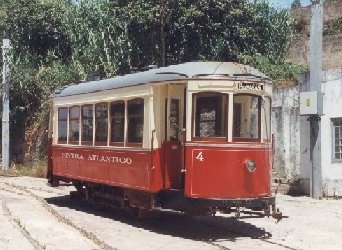
 18 November 2011 (in part)
18 November 2011 (in part)
| Sintra Town | Sintra-Atlântico Tramway | Scott URB/ Stagecoach Portugal Buses | Sintratur- Horse Drawn Tours |

Compiled by John Laidlar
Background
The Sintra-Atlântico Tramway has enjoyed a revival after a period of near extinction 30 years ago and was extended in 2004 back towards Sintra town centre. Eventually it is hoped to return the tracks as far as Sintra railway station (a further half-mile or so nfrom the current Estefania terminus). The line goes to Praia das Maçãs, a small seaside resort on the Atlantic. However, as of November 2008 only the short section from the town (Vila) to the tram depot was operating due to landslip problems but since 2009 the whole line to between Estefania and Praia das Maçãs has been operational. Winter services are normally limited to Friday to Sunday only.
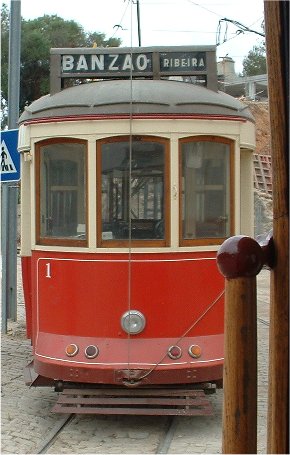 |
Left: Tram no.1 at Ribeira, June 2005 Right: Tram 6 in June 2005. |
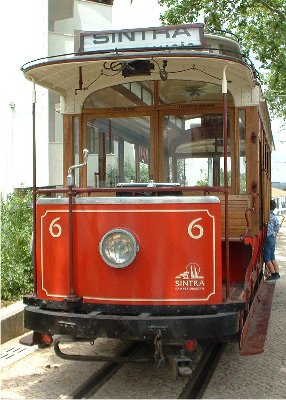 |
Sintra Town
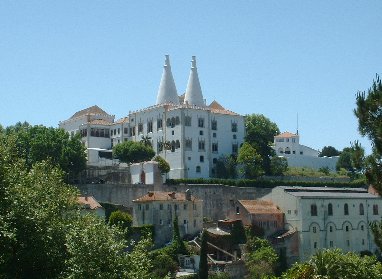
Sintra's Royal Palace, with its distinctive chimneys.
Sintra is a small town, in a spectacular setting, situated 28km from Lisbon. It houses a Royal Palace, used by generations of Portuguese royalty prior to the 1910 revolution. The surrounding hills are surmounted by the remains of the Moorish Castle and by the nineteenth-century Pena Palace. The town, which lies at 207 metres above sea-level, may be reached by CP (Portuguese Railways) services from a variety of Lisbon stations. For details of the Linha de Sintra railway line, click here.
The town has a picturesque and historic part and a more modern, functional area. The historic centre lies a pleasant ten-minute walk to the from the station booking hall (turn left on exit). Alternatively, a bus to the centre may be caught from the bus stop opposite the station. The centre of Sintra has a number of cafés which afford fine views of the royal palace; these tend to be a little dearer than Lisbon equivalents, but customers are paying a premium for the view. Other services from Sintra Station include routes operated by Scott URB, the successor to Stagecoach Portugal which ran services till 2002 (see below).
Sintra-Atlântico Tramway
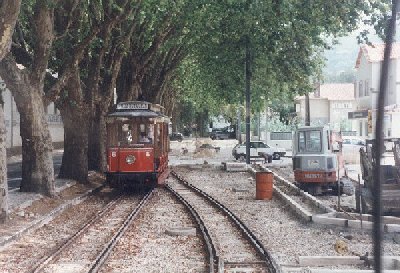
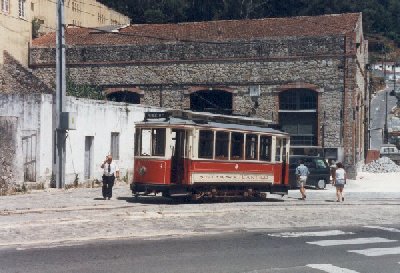
L to r: Sintra-Atlântico tram no.6 at Banzão; tram 3 at Sintra Ribeira shed.
The oldest part of the tram route, from Sintra to Colares (about half way to the current terminus) opened on 31 March 1904. It was extended to Praia das Maçãs by 10 July 1904 and this service was known as Cintra ao Oceano - Cintra was the old spelling of Sintra. The route formerly started from Sintra railway station but, between 1930 and 1954, it terminated a few kilometres up the coast beyond Praia das Maçãs at Azenhas do Mar. After a threatened closure in 1950, the Council insisted on the retention of at least a summer-only service and this operated from 1953. But, following the upheaval of the Portuguese Revolution, between September 1974 and 1980 no tram service at all was operated. Then, a 3km stretch from Praia das Maçãs to Banzão depot was re-opened but only served by irregular services.
A marked upturn in its fortunes came with the arrival of Stagecoach Portugal who were operators of the system until 2001. At that time the trams ran from the main depot at Ribeira de Sintra, on the outskirts of the town, to Praia das Maçãs. In mid-June 2001, Stagecoach announced the sale of their Portuguese operations to ScottURB. However, the Sintra local council now operates the tram service. Its website is a source for local information. The Council has been developing the service in recent years as a tourist attraction though services are also used by locals. Much of the route was relaid in the 1990s using narrow gauge track from Portugal's diminishing northern railway network.
The Route
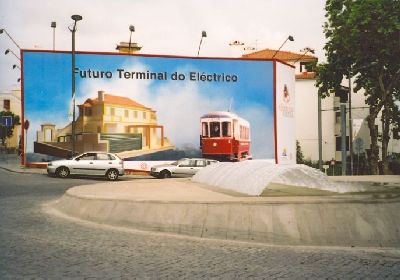
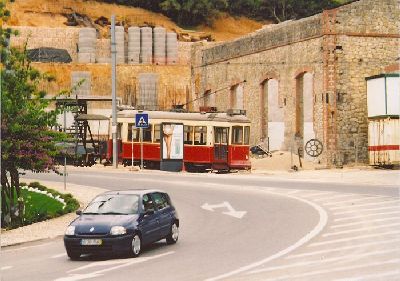
Above left: The terminus in Sintra town (2005). Above right: Refurbishment of the depot at Ribeira de Sintra (2005)
The 14km route to Praia das Maçãs, mainland Europe's most westerly holiday resort, now commences in the Estefânia district of modern Sintra - the modern part of the town, which lies to the right as your emerge from the station booking hall. (Keep walking till you pass the Sintra Museum of Modern Art on the left, about five minutes or so from the station). The tram terminus is just beyond the Museum, opposite an impressive modern fountain. Next to the terminus is a huge set of advertising sheeting which proclaims that a new tram terminal building is to be opened there. A service timetable is displayed at the terminus. There is a very good little café across the road, called the Solar Saloio, which does excellent hot sandwiches and is a good place to visit if you have to wait for a tram.

The tram's route.
An alternative tram boarding point for visitors is at the former terminus of Ribeira de Sintra, about five minutes or more along the track from Estefânia. The adjacent Ribeira tram depot was gutted by workmen in 2005 and re-building is going ahead at the upper depot level. Ribeira can be reached from the historic down by walking about 1km down the hill past the Hotel Tivoli, near the Royal Palace. A small, but friendly, café is situated yards from the Ribeira depot in which are displayed photographs of the tramway in bygone days. However, boarding at Ribeira robs you of some of the best part of the route as the tram winds its way down a steep and winding hill (Monte Santos) on newly relaid track which passes the Hockey Clube de Sintra and which has a passing loop. Ribeira itself was the terminus till 2004, but in 2003 the local Council started to re-extend the terminus back to its current terminus at Estefânia in the town centre as part of a contract worth 2.5 million Euros.

Left: Praia das Maçãs beach.
As well as at Ribeira, there is also a (smaller) tram shed at Banzão, roughly halfway along the route to Praia das Maçãs. Ribeira shed formerly had two sections which were connected by new track. The lower (currently gutted) section at Ribeira is adjacent to the main road, whilst the upper level was only reachable with permission of the company, as it adjoined local homes. By 2002 the upper shed at Ribeira was in a parlous state, with a condemned roof, but it housed a number of unrestored vehicles. The council now appears to have demolished this and to be enacting its plans to create a tram museum in the former Ribeira power station. It also has plans to erect a 200-bed hotel, nearby, together with a small shopping centre. However, a project to built a funicular to link the Ribeira depot with the town of Sintra has been abandoned.
Shortly after Ribeira, the tram makes one of several crossings of the adjacent main road to enter more reserved track as it heads towards Galamares (15 mins from the starting point). With the Monserrate mansion and other impressive buildings on the hills to the left, another passing loop is passed before the tram winds towards the major intermediate stop at Banzão, with its small tram depot on the left and the large premises, on the right, of the local cooperative winery, the Adega Cooperativa de Colares. There is also a passing loop here. The tram now goes along the Avenida do Atlântico, still alongside the main road, on reserved track. The tram finally arrives at its seaside terminus of Praia das Maçãs after a journey of some 45/50 minutes. The Atlantic Ocean is just across the road (100 yards). Praia das Maçãs is a small seaside resort with a sandy beach and a number of restaurants and cafés. The Oceano restaurant at the terminus itself can be recommended as can the much smaller bar across the road and slightly further up the road from the tram terminus.
As mentioned above, for several years services were upgraded and operated by Stagecoach Portugal, who promoted the service to tourists. Tram ticket sales in 1997/98 totalled 15,164 for the year to September. In the January to April 1999 period services operated at weekends using one vehicle only. The trams themselves have continued to bear the name of the pre-Stagecoach operation, Sintra-Atlântico, and have an attractive red and cream livery.
In 1999 Stagecoach services were advertised to operate the full route seven times a day in each direction during the summer peak season and weekends between April and June. However in 2000 services were confined to four per day in each direction on Wednesdays to Sundays only and by summer 2002, the trams were only operating at weekends. Services in summer 2005 were improved and run roughly hourly but operate on Friday to Sunday only but as of winter 2008 only a skeleton service was operating between the town centre and the depot.
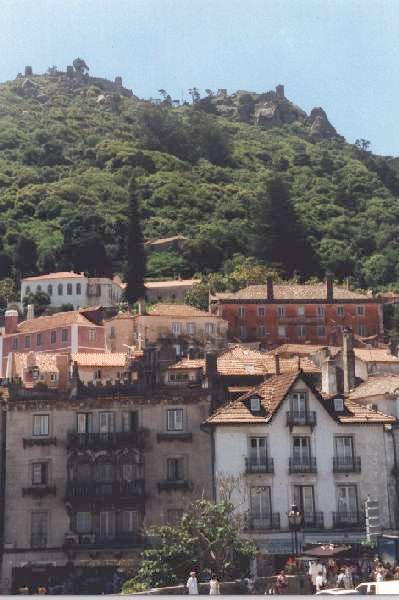
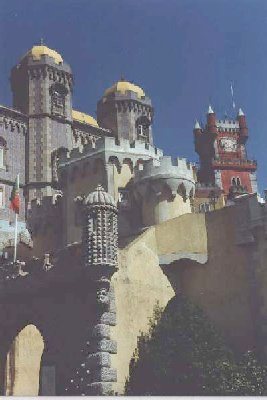
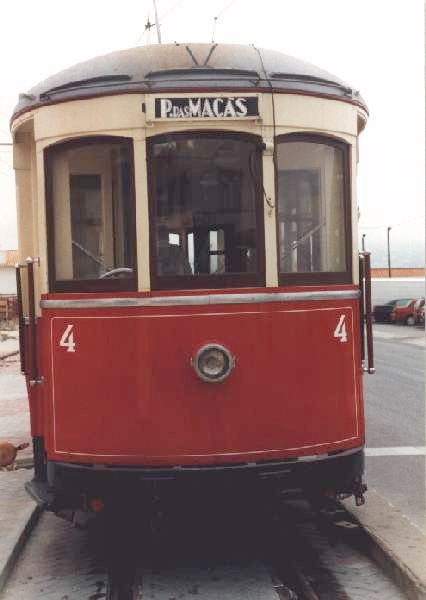
L to R: Sintra town, with the Moorish castle on the hilltop; on an adjacent hill stands the 19th-century Pena Palace; tram 4 waits at Praia das Maçãs.
In all, some fifteen trams or trailers are extant. In the Stagecoach period of ownership, Lisbon (Carris) trams #703 and #709 were acquired, whilst the "new" Sintra #1 car is actually Carris #615 on #737's truck. Ribeira also housed a Deutz steam loco used for hauling repair vehicles.
The Council also has ambitious plans for an aerial cablecar link to nearby Santa Eufemia. The Council plans to subsidy the tram operation from car-parking dues and will introduce a single ticket-type to cover all forms of local transport.
Scott URB/Stagecoach Portugal Buses
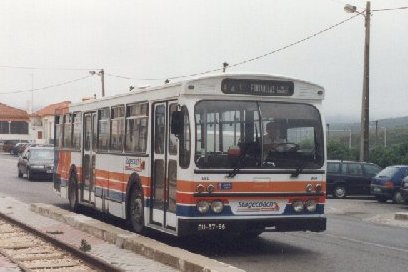

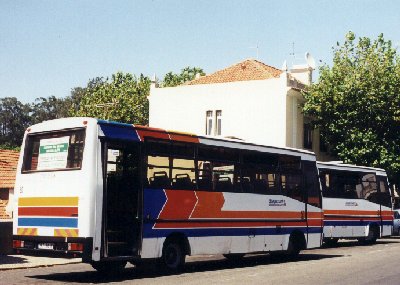
L to R: Stagecoach service 441 at Praia das Maçãs on the service from Sintra Ribeira; a Stagecoach Volvo, (fleet no.535) still in old Rodoviária Nacional livery, at Sintra Station, July 1998; new buses on the Pena Palace service, 2000.
An interesting, even hair-raising, return from Sintra to Lisbon can be had by catching the Scott URB 403 service from Sintra station via the most westerly point of mainland Europe, Cabo da Roca (38 degrees 46 minutes North, 1 degree 5 minutes West). The 403 bus service follows narrow, twisting lanes to the lighthouse at Cabo da Roca before returning south to Cascais. From there regular CP trains on the Cascais Line operate to Lisbon's Cais do Sodré station. Within Sintra a DAF FA45 minibus and UTIC-AEC vehicle provide an exhilarating ride on route 434 up the steep and tortuously winding route to the Pena Palace from the centre of Sintra and Sintra railway station.
Footnote
Stagecoach Portugal had its origins in the reprivatization of Portuguese bus and coach operation, which had been nationalized after the 1974 Revolution. In 1990, the nationalized Rodoviária Nacional was split into ten components. In the capital, Rodoviária de Lisboa was the chief operator outside the city itself, where Carris provided city bus and tram services. The name of Rodoviária de Lisboa survived as part of the Barraqueiro bus company, but another part, serving the area to the west of Lisbon, became Stagecoach Portugal in 1995. A further portion still operates as Vimeca-, Viação Mecânica de Carnaxide. In June 2001 Stagecoach announced the sale of their Portuguese operations to ScottURB for £14 million, even though turnover and operating profit for the year-ended 30 April 2000 had been £6.8 million and £1.1 million respectively. At that time, Stagecoach Portugal operated 135 buses on 60 routes in the area west of Lisbon, carrying 27 million people per annum.The main depots for Stagecoach were at Adroana, (near Cascais) and Abóboda. The Abóboda depot was scheduled for closure in 2001, when it was to be replaced by new developments at Adroana which has already assumed the status of main depot. Scott URB, like Stagecoach, is based at Rua de S. Francisco, nº 660, Adroana, 2645-019 Alcabideche, (tel. 00-351-21-469-9100); its e-mail address is here. All service vehicles continue to operate in Stagecoach livery (as opposed to former RN colours) and the new MAN vehicles (401-410) have the new corporate livery.
Stagecoach Portugal also introduced two British-registered open-top Routemaster buses into service as a tourist attraction within Sintra, on a route which linked to the tram service at Ribeira from S. Pedro de Sintra. This operated as route 400 but now appears to be defunct. During 2000 the open-top buses also operated hourly between Cascais, Guincho and Sintra.
Scott URB uses the former Stagecoach route numbers and depots. In 2005 it operates 73 routes to the west and north of Lisbon. In 2003 Scotturb carried almost 28 million passengers and its services covered 9.9 million kilometres in an area of some 33 square km. At that time it had 135 buses, whose average age was 4 years. From 1996 to 2003 a total of 135 new buses were acquired by Scott URB and in 2003 it employed 343 staff of whom 255 were drivers.
A summary of the more interesting Scott URB bus services includes:

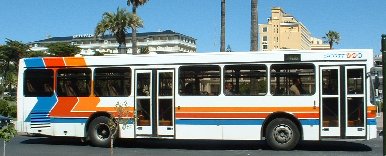
Scott-URB service in Estoril, June 2002.
The Scott/Stagecoach fleet was transformed by acquisition of sixty SCANIA L113 buses to replace an older fleet of AEC and Volvo vehicles. In all, 120 new buses were acquired in 1996.
In recent years the Scott/Stagecoach Portugal bus fleet has included Scania L113s (numbered 101-150 and 201-210), Volvo B10Rs and B10Ms, DAF A45s, Dennis Darts and a small number of UTICs, in addition to the two Routemasters formerly used for tourist services. Scott has 323 staff including 250 drivers.
Sintratur- Horse Drawn Tours
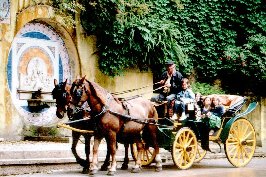 Sintratur offers carriage-rides, (from 30 mins to 2 hours) drawn by two horses, typically from Sintra-Vila to the hill-top attractions nearby. The carriages can often be seen in the vicinity of the Royal Palace or can be hired by ringing 21-924-12-38. You can also contact Sintratur by e-mail. The following routes are offered (text below is edited from Sintratur sources, for which I am grateful):
Sintratur offers carriage-rides, (from 30 mins to 2 hours) drawn by two horses, typically from Sintra-Vila to the hill-top attractions nearby. The carriages can often be seen in the vicinity of the Royal Palace or can be hired by ringing 21-924-12-38. You can also contact Sintratur by e-mail. The following routes are offered (text below is edited from Sintratur sources, for which I am grateful):
Copyright: ©
Contact: the following is not a link; please transcribe the address into your email 